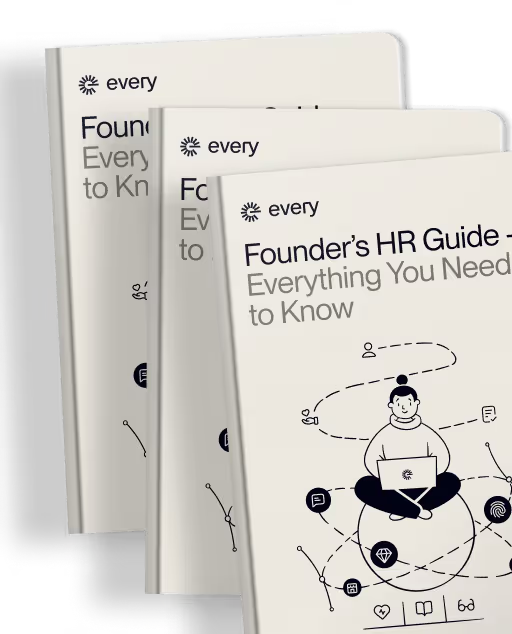Overview
Hiring your first employees? You’re now in HR
Congratulations on incorporating your startup! As a next step, you’re probably thinking about hiring your first employees. But guess what? With your first hire, you’ll need to get up to speed on HR. You might have some idea what HR is, but why should you care as a founder and CEO?
HR may not be the first thing on your mind right now, but the moment you make your first hire, you’ve got HR and People responsibilities—like compliance, payroll, benefits, and creating a culture that won’t blow up later.
When it comes to HR, you don’t know what you don’t know
For many startups, HR can become a blind spot that could lead to serious consequences for the business in the long run.
{{ebook-quote-1}}
Don’t worry, we've got you covered. Think of this guide as a quick walk-through of everything you need to know about HR as a founder and CEO. With HR best practices, checklists, lessons learned from founders, and links to useful templates, we’ll help you avoid any pitfalls from the get-go.
HR is more than just paperwork
- HR is not just about managing payroll & employee leave.
- HR is important because it involves being compliant with state & federal labor laws and establishing workplace policies & procedures.
- HR also includes hiring, onboarding/offboarding, compensation, benefits, and training.
- HR is about creating an engaged and innovative workplace culture.
- HR is about protecting your employees, your business, and your future.
- HR is the first building block for scaling a sustainable business and workforce.
- As CEO, HR is a key responsibility; get up to speed now.
Why HR matters from Day 1 (And why you should care)
HR sounds boring…until you get fined or an employee sues you
Hiring employees requires compliance with federal and state labor regulations; failing to do so risks hefty fines or lawsuits down the road.
- A study by the National Small Business Association found that the average small business owner faces compliance costs of nearly $8,000 in the first year alone.
- Last year, a former ZocDoc employee sued the company for a culture they believed replicated a college frat house.
Depending on your state, some regulations take effect at 50 employees, others at 15 employees, and some at the first employee. HR Compliance means ensuring your startup’s policies and actions follow these regulations. It means protecting your employees, creating a safe and positive work environment, and avoiding expensive fines and lawsuits.
Don’t “wing it” when it comes to hiring - it will cost you
Hiring is probably your top priority. And you’ll want to be strategic with your first hires. They’ll set the stage for your product, your business, and your culture. HR hiring best practices can help you hire the right people with the right skills and experience from the start.
Why? Hiring the wrong person impacts your bottom line.
- High cost of turnover: 1.5 to 2x an employee’s annual salary includes both the cost of hiring and impacts to workforce productivity & morale.
{{ebook-quote-2}}
Culture is not fluff. It’s key to a sustainable business.
So yes, HR is about being compliant with government labor regulations and hiring the right people, but HR is also about creating the right workplace culture. HR is about building a culture of innovation, failing forward, and fast pivots - all key to your startup’s long-term success.
HR is also about motivating, recognizing, and developing your employees. Essentially, HR is the cornerstone to scaling your workforce and building a sustainable business.
HR is serious stuff. Should I hire an HR manager?
The good news is you don’t need to hire an HR manager just yet. A dedicated HR manager is recommended for 20-30 employees, and a senior HR leader for 50 employees, when many federal labor regulations kick in. But you’ll want to designate someone in the company to be responsible for HR-related tasks.
You might want to rely on an all-in-one HR tool or platform to do most of the heavy lifting for you. And you’ll want to read up on what HR means exactly for your startup business.
Here’s a Founder’s HR Guide to help you every step of the way
Don’t wait until hidden fines pile up or you have to fire someone, get in the know and put your HR hat on now.
Hiring Best Practices
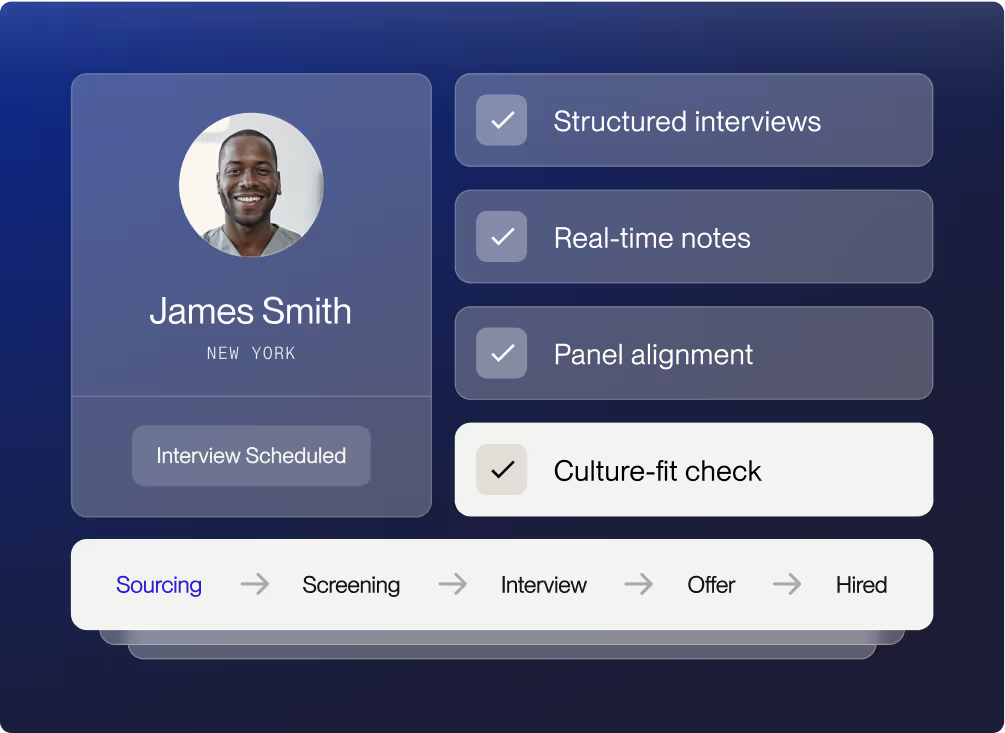
Hiring is probably your top priority. But don’t just hire quickly to fill roles. Avoid this common startup mistake. As a founder and CEO, you’ll want to invest your time in hiring the right person.
Why? Turnover has high costs on both your bottom line and company morale. Turnover costs are usually 1.5 to 2x an employee’s annual salary. So creating an effective hiring process and finding the right candidate with the right skills from day 1 is key to your startup’s success.
Design every step of your hiring process to help you identify the best talent, as well as stick to federal and state labor regulations.
Here’s a HR hiring best practices checklist
1. Register in the state where you plan to have your HQ and/or where you have a presence.
- Most likely, you’ve incorporated your startup in Delaware, but you'll also need to register your startup as a “foreign entity” in the state where you plan to have your HQ.
- This means registering with the Secretary of State in that state. You'll also need to set up payroll taxes in the state where any of your employees reside (even if remote).
- As your startup grows and you hire employees in different states, the rules for when you need to register vary by state.
- In some states, you'll need to register if you have even a single employee or if you're doing any sales there, while in others, you need a more substantial presence.
- Talk to your attorney as you expand to determine when registration is necessary and appropriate.
Resource: Every–an all-in-one HR Payroll, Benefits, & Compliance platform–can help you with foreign qualification, registration, and payroll taxes in all the U.S. states you plan to do business and hire employees. Find out how Every can help you.
2. Don’t just get AI to write a job description
While it’s easy to get AI to write a job description, don’t just cut & paste. Think strategically about what kind of role and skills you actually need.
For example, how will this new employee fit in with you and your co-founder’s skill sets? What skill gaps are you missing? Writing a good job description is about attracting the right candidates as well as developing an org chart and clearly defining who does what, so there’s no confusion from the get-go.
As you craft your job description, here’s a quick checklist:
Role & responsibilities
Job title
- Create the right title that matches the type and level of the role, as well as compensation. Mismatched titles can lead to the wrong candidates applying.
- Avoid inflating titles or giving out C-Suite titles too early in your startup journey. It’s often challenging to “demote” early hires when you need a more seasoned and experienced leader at later stages.
Worker classification
- Will they be full-time, part-time, or contract?
- Will they be in the office, hybrid, or remote?
- Classification matters when it comes to compliance with labor and tax laws, so be clear on this. Many startups overlook worker classification–leading to unexpected fines and penalties.
- Read more information.
Key areas of responsibility
- What will be the new employee’s remit and scope?
- List responsibilities and tasks out clearly and concisely in a few bullets.
- Clearly defined boundaries help avoid overlapping roles and conflict later.
- During early startup days, employees often get their hands involved in multiple pots, and that’s OK. But at the end of the day, it’s still important to hold one person accountable.
- You’ve heard the phrase – the fastest way to starve a horse is to assign two people to feed it.
- The buck needs to stop with one person (and it can’t always be you), or let’s face it, balls will get dropped.
Expected impact or objectives
- This is the role’s north star and the impact you want this employee to have in the big picture for your startup.
- This is also where you can excite and inspire the candidate to join your journey to build something new.
Reporting structure
- Mention who this employee will be reporting to, so it’s clear.
Skills & qualifications
Map out the exact skills and experience you are looking for. This can then feed into your interview rubric and help you select the right candidate (more on this later). Think of these skills in three main areas:
- Experience (e.g., number of years, types of roles or companies, etc.)
- Skills Competence (e.g., specific skills, certifications/degree, knowledge, & ability to perform them successfully on a job in a real-world context)
- Soft skills that align with your company values (e.g., collaborative, innovative, etc.)
You can also break these out into “must-have skills” and “nice-to-have skills.”
Ideally, you’ll want to find a candidate who has just experienced scaling a startup to the level where you want to go next. They’ll have a wealth of lessons learned, so you don’t need to reinvent the wheel.
A few more things to think about in your JD:
About us paragraph: Explain your company, product, and market you are trying to revolutionize, as well as offer a glimpse into your workplace culture and company values.
Location: If this is a full-time or hybrid role in the office, list the location. If this is a remote full-time role, you’ll still need to list the states you are legally permitted to hire employees in.
Benefits & compensation range: List the benefits you offer, like health, dental & vision, and paid time off. Some states and cities also require transparent pay and salary ranges to be published on your job description, so you’ll need to check state and local regulations where you plan to hire employees.
Compliance: Finally, check that your job description is compliant with federal and state regulations. For example, you’ll want to avoid any language that may be viewed as discriminatory or exclusionary, such as age, gender, or race-based preferences. Title VII of the Civil Rights Act prohibits discrimination in the workplace based on race, color, religion, national origin, age, and sex (including sexual orientation, gender identity, and pregnancy).
Resource: LinkedIn has some great job description templates by role to get you started here.
3. Don’t hire your college buddy, but do tap into referral networks
Just sticking your job description up on LinkedIn is probably not going to do much. No one knows who you are. You’ve got zero brand. So it’s going to be hard to attract anyone good. Sure, you might get a slew of resumes, but you don’t have the time to vet them either.
During the early-stage startup hiring phase, you’ll have to lean in heavily on referrals in your network. But don’t just hire your friends to fill roles quickly.
- Lean on your VC, advisor, and co-founder networks to identify the right candidates with the right skills for the role.
- Leverage LinkedIn’s first-degree and second-degree connections in your network to source potential candidates with experience at mature startups in your industry.
- Invest time in nurturing potential candidates and inspiring them about your startup’s vision and how they can have an impact. This might mean several coffees, lunches, and Zoom calls before they even agree to a formal interview.
4. Avoid any interview faux pas - master the art of interviewing
Interviewing a candidate seems easy enough. However, done poorly, it could lead to hiring a bad apple or, worse, a lawsuit down the road. And avoid asking any illegal interview questions–a common newbie CEO mistake.
As a founder and CEO, avoid any interview faux pas and master the art of interviewing.
Rely on objective and transparent criteria during your interview and selection process to help you identify and hire the most qualified person, as well as avoid any legal challenges down the road.
- Create a structured interview scorecard. Turn the list of key skills and qualifications in your job description into an interview rubric and scorecard for each candidate. This helps you ensure a transparent and objective evaluation process that eliminates bias and identifies the best talent for the role. Rate your candidate across each of the skills in your rubric (1-5).
- Document why a candidate was selected or not selected. Taking detailed notes in your scorecard can also help protect you in the event of a discrimination lawsuit.
- Create a list of focused interview questions for each interviewer. Make a list of questions that help you assess each skill and experience in your interview scorecard. Assign each interviewer a different focus area to evaluate and create a unique list of questions for them. Also, add a list of what NOT to ask as a reminder of what’s legal and illegal.
- Avoid asking any illegal interview questions. Don’t ask any illegal interview questions about age, ethnicity, criminal history, marital status, pregnancy, disability, religion, sexual orientation, work or visa status, plans to start a family, or any other categories protected by law.
- Stick to questions solely about the role, skills, and experience. Non-job-related questions, like asking about relationships or personal habits, may also be non-compliant. Even asking about hobbies can open the door for bias during an interview. For example, if you both share the same hobby, it might create an unconscious preference for this candidate, unrelated to whether the person can do the job well or not.
- Conduct a de-brief with your interview panel. Fill out your scorecard and notes before talking to anyone else who interviewed the candidate to minimize any outside influences. Then have a quick debrief meeting with the other interviewers to share the pros and cons of each candidate. You, as the CEO (and likely the hiring manager), should always share your thoughts last. While the hiring manager always makes the final decision, it’s still good to hear what others think first to make sure you’ve evaluated the candidate from every angle.
Resource: Here’s a link to an interview scorecard template
5. Assign them an assignment or conduct role-play scenarios during the interview.
- Some people interview well, so you’ll want to dive deeper by checking whether they can produce the work.
- In the world of AI, take-home assignments might be too easy, so you might want to try real-time assignments during the interview, like problem-solving on the whiteboard for engineers or role-playing scenarios for other jobs.
- For leadership positions, live presentations on their proposed strategy for your startup are also great.
Video - Advice from Rajeev Behera, Founder & CEO of Every and former Co-Founder & CEO of Reflektive on how to spot a bad hire before it's too late
6. Do your due diligence - reference, offer letter, & background check.
It’s easy to fall in love with a great candidate, especially one who interviews well. But do your due diligence.
Check at least three references - ideally, former managers.
- Once you identify a candidate who meets your criteria, request at least three references from their most recent jobs and schedule a 15-minute call with each of them as soon as possible.
- Don’t skip this step. Many startups do, and discover too late that the person didn’t have the skills or experience they sold in the interview.
- The three references should ideally all be their former managers rather than a friendly colleague.
- Connecting with their former managers is also a great way to get to know your candidate’s strengths and weaknesses, which can help you set them up for success as their new manager.
Here’s a standard list of reference questions:
- What is your role in relation to the candidate? How long did you work together? Approximately what dates and at what company?
- What were their roles and responsibilities at your company?
- What was their impact? Can you share one successful project and its impact?
- Can you list their top 3 strengths?
- Can you share 1-2 areas of improvement you saw at the time?
- How would you grade the candidate in terms of an A, B, C, or D? (And ideally, only hire A players)
Create an offer letter.
- If the candidate’s references check out, create an offer letter template and contract that includes compensation, job classification, job description, benefits, at-will status, contingencies (e.g., background check), non-disclosure agreement, and required documentation (I-9 form).
- The candidate will need to sign the offer letter and contract. Give them a deadline, like the weekend or 48 hours to sign the contract.
Resource: Employee offer letter template here.
Conduct a background check
- Make the offer contingent on the background check. The background check is helpful to confirm former employers, education, and any previous criminal record.
- Remember in order to conduct a background check, you will need the candidate to sign an authorization form by law.
- Many vendors can help you conduct a background check.
Rejection Email
- Finally, always send a polite, non-discriminatory rejection email to candidates you didn’t select as well.
Resource: LinkedIn has sample rejection email templates you can use here.
Now you’ve hired a great candidate, read on to find out what else you need to do when it comes to HR.
Compensation, Benefits & Leave
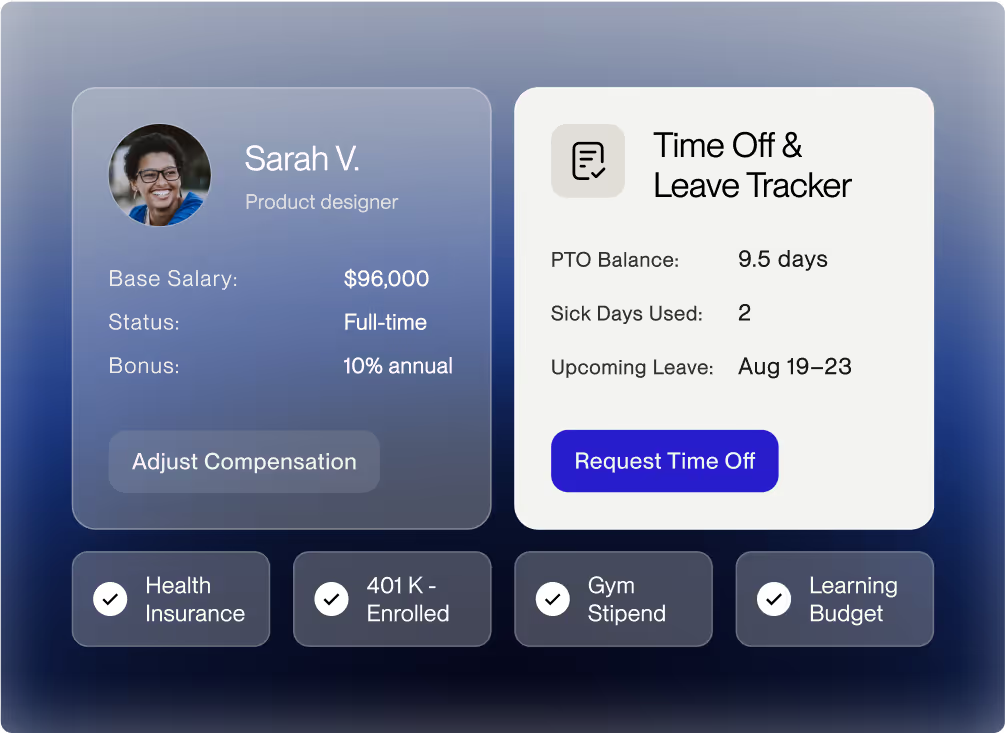
When you find a great candidate, don’t just rush to offer a salary that makes them happy. Do your homework. And don’t forget to consider benefits and PTO in your offer as well.
Here’s everything you need to know about compensation, benefits & leave.
Get compensation right from the start.
Compensation is more than offering a competitive salary; it’s also about being compliant with the law and making sure you pay each employee fairly—or you’ll risk legal challenges.
The Federal Equal Pay Act prohibits the practice of offering different levels of compensation based on gender for jobs that involve equal skill, effort, and responsibility. It includes all types of compensation, including salary, overtime, bonuses, stock options, and benefits.
Fair pay practices involve avoiding wage discrimination based on factors such as gender, race, age, religion, national origin, or disability.
Unequal compensation is one of the fastest ways to dampen company morale, productivity, and employee retention. And what’s worse, it could lead to a lawsuit.
A typical startup mistake is paying employees at wildly varying salaries for similar levels and roles. Not only is this illegal, but it can also lead to future problems.
Let’s face it, no one wants to find out a peer at the same level is paid a lot more. And it’s a lot harder to cut an employee’s compensation later, so get it right from the start.
- Research competitive salary ranges for the role in the labor market based on industry benchmarks and the cost of living in the regions you plan to hire.
- Map compensation with your budget, including giving annual raises.
- Create pay ranges for each role and level within each function, such as Director versus manager.
- Ensure that you avoid any discrimination when it comes to pay and that similar titles have similar salary ranges to prevent gender or racial pay gaps.
- Check local regulations - some states and cities require pay transparency by law. For example, this might mean publishing salary ranges in your job descriptions and ensuring pay equity within your company.
- Offer stock options as a recruiting tool, but you’ll also need to work with your attorney on ensuring you comply with regulations regarding stock options and equity grants. Resource: Carta has some great stock option planning templates here.
Don’t overlook benefits required by law.
Specific benefits are required by state and federal law, such as unemployment insurance, disability insurance, workers’ compensation, and retirement benefits, including 401(k) plans.
- Most states require you to have workers’ compensation insurance in place to cover employee work-related disability or illness, even if you only have one employee.
- In some states, state unemployment and disability insurance are covered by payroll taxes, but in other states, they may be managed differently.
- For example, in California, state disability insurance is funded from payroll taxes, and the insurance is managed by the state.
- In contrast, New York State requires payroll deductions for state unemployment insurance and workers’ comp insurance, but leaves it up to employers to purchase insurance from state-approved carriers.
- Some states, like California, also have a mandatory retirement plan law that requires companies with five or more employees to offer retirement savings options, such as 401(k) plans.
- State regulations vary, so check your local state regulations.
Resource: Partner with Every to stay compliant with the benefits required by law
At Every, we proactively remind our startup customers when they hit the employee size threshold and are required to obtain certain benefits. For example, workers’ comp becomes mandatory when you hire your first non-owner W-2 full-time employee. Through our partners, we also support compliance with state-specific benefits and help our founders identify state-approved insurance carriers for workers’ comp insurance or 401(k) options. Find out more about how Every can help you.
Offer healthcare benefits to be competitive.
- The federal Affordable Care Act only requires businesses with 50 or more employees to provide health care insurance.
- However, to remain competitive and attract top talent, you may need to offer comprehensive benefits packages, including medical, dental, and vision coverage, from the outset.
Resource: Every’s HR platform, designed specifically for startups, can put together small-group health insurance benefit packages for you and your co-founder, as well as your employees.
Find out more about how Every can help you offer employee healthcare benefits.
To vacation or not?
- There are no federal laws mandating paid vacation time, so whether or not you offer paid vacation is entirely up to you as an employer.
- However, if other startups in your industry offer paid vacation or unlimited paid time-off, then you’ll want to do so as well to be competitive.
- To ensure employee well-being and productivity, you also may encourage your employees to take time off to rest and recharge.
There are federal and state regulations requiring unpaid leave for specific qualifying events, such as medical reasons or childbirth.
- The federal Family and Medical Leave Act (FMLA) kicks in at 50 employees, while in California, the California Family Rights Act (CFRA) kicks in at 15 employees. These laws require 12 weeks of unpaid leave for personal medical reasons, childbirth, adoption, or caring for a sick family member.
- Some states also require paid sick leave.
- Check state regulations on family and medical leave. If you hire employees in multiple states, you must ensure compliance with state regulations.
Culture & Workplace Environment
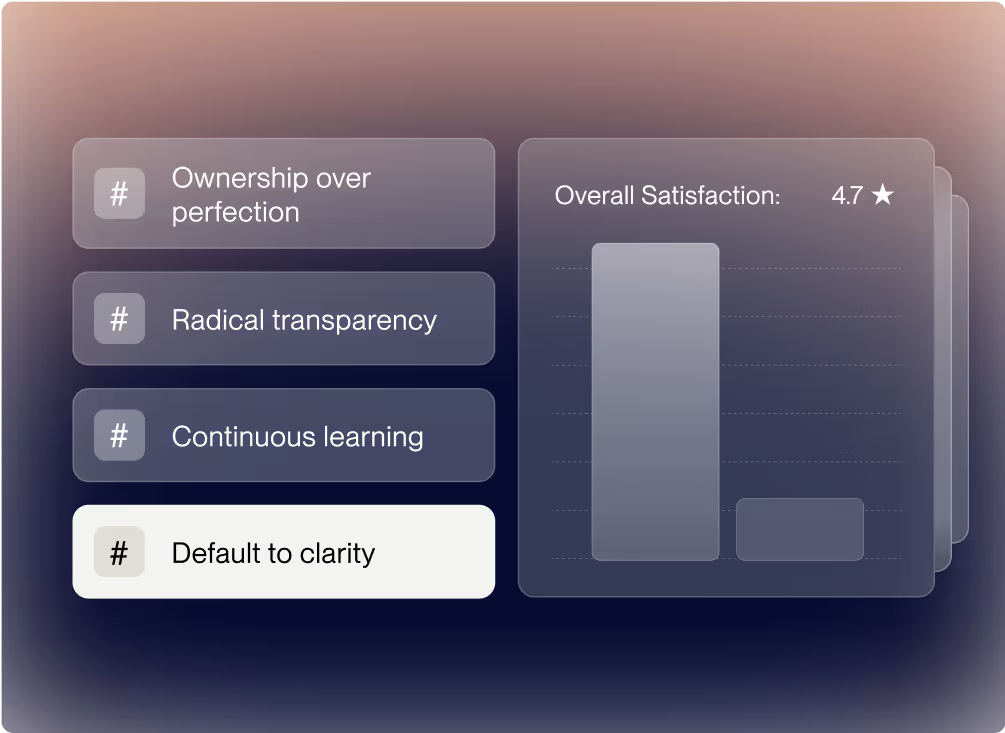
Culture isn’t just fluff; it impacts your bottom line. Studies show that a positive workplace culture and connected team lead to increased productivity and revenue.
That’s right, if your culture results in happy and motivated employees who love coming to work every day, your startup will achieve higher revenue.
And of course, the opposite is true as well. Dysfunctional and toxic startup cultures often lead to dysfunctional businesses.
That’s why it’s important to create the kind of culture and workplace environment you want at your startup on Day 1.
What makes a positive workplace culture?
First, let’s break down what contributes to a positive workplace culture. As a leader at your startup, how you lead & manage has an outsized impact on your workplace culture. Here are a few factors to think about how you, as a CEO and founder, can build a positive culture.
1. Psychological safety
When employees feel safe to share their opinions freely (even if they contradict their boss’s opinion), your startup and product will benefit from the best and most innovative ideas.
What’s more, if they can experiment and make mistakes without repercussions, your startup will thrive and innovate faster than your competitors.
What you can do:
- Always listen
- Ask for opinions and feedback
- Be open to opposing opinions (after all, they help test your ideas)
- Encourage experimentation and failing forward
- Don’t penalize mistakes, learn from them
- Treat employees with respect and always communicate professionally
- Avoid knee-jerk responses and don’t get emotional or angry.
- Take a deep breath before you react negatively to something and think carefully about how you can respond constructively and empathetically.
2. Transparent & open communication
A thriving workplace culture relies on open and transparent communication from the top down and the bottom up. This two-way communication builds trust and employee engagement.
Secrecy and uncertainty at a startup often lead to a toxic work environment and result in disengaged employees, so you’ll want to avoid going down this path.
What you can do:
- Always keep your employees in the loop and communicate transparently, whether it’s good or bad news, at company meetings and on Slack.
- Create avenues for bottom-up feedback, allowing your employees to express their concerns and ask questions regularly.
3. Belonging, teamwork & collaboration
Studies show that high-performing teams are closely-knit teams built on strong bonds, friendship, and trust. Think of a winning sports team. When people feel like they are part of a team and community, they are more engaged, go the extra mile, and have fun while doing it.
Teams that are collaborative and have each other’s back — opposed to teams that are competitive and backstabbing— perform better.
However, don’t leave this to chance; you need to intentionally cultivate a sense of belonging, trust, and collaboration.
What you can do:
- Be inclusive by soliciting and valuing every employee’s opinions and inputs equally. Don’t play favorites.
- Build collaboration and teamwork rather than competition by ensuring open communication and shared decision-making. Streamline how information is shared so that everyone is kept informed. Ensure key people are included at meetings, meeting notes are shared, and key updates are provided during team meetings or on Slack. Encourage co-creation on projects and celebrate successful teamwork.
- Schedule fun and team-bonding activities that are open to everyone, like bowling, going on a hike together, or going out to lunch or dinner as a team.
- Organize a company retreat in a relaxing location, if budget permits. Combine work and training sessions with fun, team-bonding activities.
4. Shared company values
Shared company values create the foundation of your startup’s culture and a guidepost for employee behavior.
What you can do:
- You’ll want to be intentional and put pen to paper. Craft your “company values” with your co-founder and/or your OG team. These are usually 4 or 5 key company values that will serve as your startup’s cultural compass.
- And then really live and breathe these values. Don’t just make them live on a piece of paper.
- Use your company values as your yardstick when sizing up candidates to bring on board. There should always be a company values section in your interview scorecard, and create interview questions you can ask to evaluate candidates based on these values. For example, if collaboration is a company value, then screen candidates for this trait. The key to creating the kind of culture you want is bringing in people who share these values.
- Training is key to living by your cultural values. For example, if empathy is a key cultural value, then you’ll want to train you and your employees to develop this soft skill.
- Ensure that your employees embody these values. Reinforce your company's values by giving your employees regular positive recognition and constructive feedback. You may also want to incorporate company values into your performance evaluations.
- Give out employee-nominated awards. Recognize employees and teams who are aces at exhibiting your company values quarterly and announce them at All-Hands. (This will come at a later stage as your startup grows).
- Finally, role model these values yourself.
5. Learning, feedback & recognition
To motivate and engage your employees, you’ll want to create a culture that enables them to learn and grow through positive & constructive feedback loops as well as learning & development opportunities.
What you can do:
- Celebrate and recognize employee work regularly. Give frequent shoutouts at company meetings and on Slack.
- Provide positive and constructive feedback consistently and effectively, not just during annual performance reviews.
- Provide leadership and soft skills training for you and your leaders, especially if you are first-time managers. For example, you may want to offer a workshop, online course, or suggest a book for your employees, leaders, & yourself to learn how to give feedback effectively and empathetically. A leader who yells at employees when giving negative feedback is one of the fastest ways to slip into a toxic workplace culture.
- Offer learning & development opportunities. Your employees will no doubt be winging it in areas they know nothing about at times. That’s startup life. Consider paying for online courses on Udemy or LinkedIn in specific skill areas, so they can learn fast. It’s rewarding for them to grow and acquire a new skill, plus you ensure the project gets done right.
- Ensure you conduct compliance training. Finally, conduct the necessary training to be compliant with federal and state labor regulations. For example, in California, sexual harassment training is required for companies with 5 employees or more. Other important training that protects your company also includes IT security, data privacy, and DEI training.
6. Employee well-being & safety
Ensuring the physical and mental well-being of your employees is a key element of creating a positive and safe work environment. And it’s also required by law.
Federal and state regulations will require you to ensure a safe and fair workplace that protects your employees’ physical and emotional well-being.
For example, federal OSHA regulations enforce worker safety protection to prevent preventable injuries and illnesses.
What you can do:
- Protect your workforce through regular training, breaks, providing PPE, and regular monitoring, depending on your industry.
- Schedule regular OSHA consultations, display posters, handle any workplace hazards, and report any injuries in a timely fashion.
- For office workers, ensure that employee workstations are ergonomic and allow for regular stretch breaks.
- Encourage time off and work-life balance, so your employees have time to recharge. This will help their productivity in the long run, as exhausted workers lead to mediocre work or worse, mistakes.
- Provide healthcare benefits to support physical and mental health. All-in-one HR platforms offer healthcare benefits packages for startups. Find out how Every can support you.
Last step: Create an employee handbook
You may recall signing a student handbook with a code of conduct in school or an employee handbook at your previous workplace. And maybe you thought it was just fluff. Well, it’s not fluff.
An employee handbook lays down the framework for your company culture and how you expect your employees to behave. And most importantly, it protects you against employee lawsuits down the road.
Once you have hired a few employees, it may make sense to create an employee handbook.
Here’s why:
Your handbook is a great place to formalize your company values. An employee handbook also helps ensure compliance with any labor regulations and sets expectations.
It formalizes and communicates your company's policies on:
- Conduct and discipline
- Leave and time off
- Company values and code of conduct
- Remote work expectations
- Anti-harassment procedures
- Use of company devices and email
- Termination of employment
- Your handbook can protect you against potential lawsuits by clearly communicating your company’s policies, so there is no confusion when disputes arise.
- Always have an attorney review your handbook to ensure it's accurate and compliant with federal and state regulations before publishing it.
- Have your employees acknowledge these policies and sign the handbook. File these signed employee handbooks safely.
- Finally, regularly review your handbook and update it to reflect legal changes.
Resource: Indeed has an Employee Handbook template you can use as a starting point.
Employee Onboarding Checklist
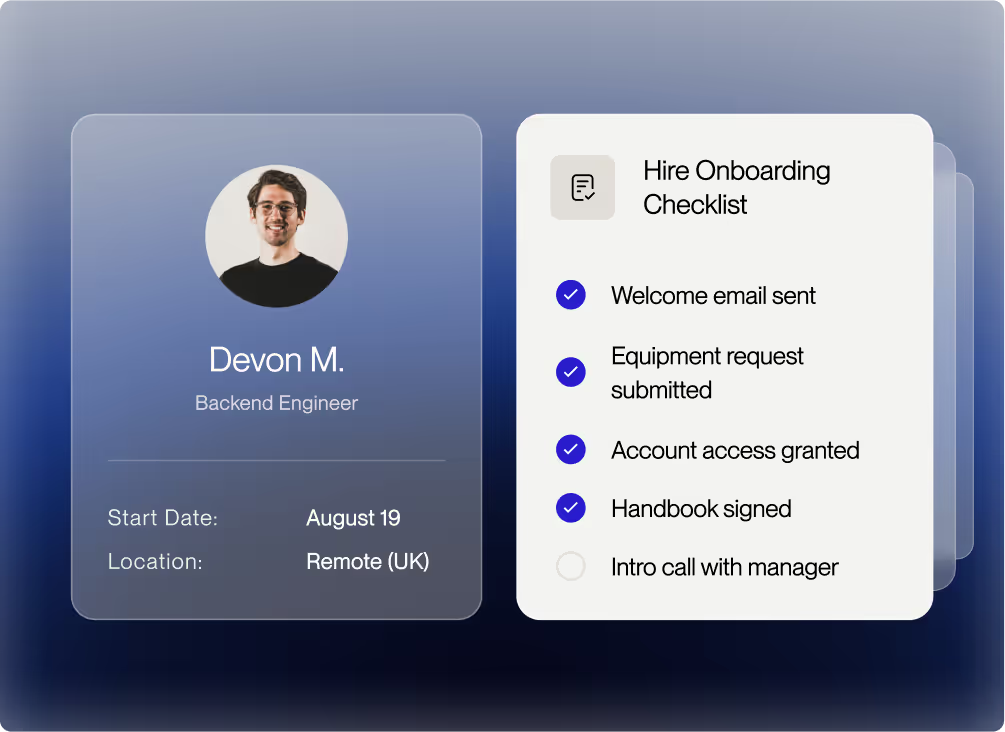
Congrats, you’ve hired your first employees! Now what? You’ll need to onboard your employees to set them up for success, as well as adhere to key federal and state labor regulations.
Here's an onboarding checklist to help you get started.
1. Signed Offer Letter & Employee Contract
Once you receive the offer letter & employee contract signed by both parties (yourself and your new hire), you’ll need to make sure you file it safely and securely.
2. Signed Background Check FCRA Authorization Form
You’ll also need to ask your new hire to sign a background check FCRA authorization form, so you can legally conduct a background check. Vendors that can help with employee background checks.
3. Verify Your New Hire Can Legally Work in the US
On your employee’s first day, you and your new hire will need to fill out Form 1-9 to verify your employee’s identity and authorization to work in the US.
You’ll need to ask and review your employee’s passport, green card, work visa, or birth certificate to correctly fill out this form and confirm their right to work in the US.
You must ensure that you correctly complete and store the Form I-9 for each employee within three business days of their start date.
You don’t need to submit the form to any government agency, but you do need to legally file it and have it ready should an agency request it.
4. Collect W-4 Tax form and Social Security Number
Ask all new employees to submit a signed W-4 form upon starting work and keep it on file. This form will help you determine how much income tax to withhold from an employee’s wages.
You’ll also be required to get your employee’s Social Security number. Don’t accept ITIN in place of a Social Security number. ITIN numbers begin with 9 and do not signal eligibility to work in the United States.
You’ll need to include their Social Security number when you file their W-2 form at the end of the year with the IRS to report the employee’s wages and taxes withheld for tax filing.
Also, be sure not to confuse the W-2 with the W-4 form. The main difference between the W-2 and W-4 is their purpose. The W-2 is issued by employers annually to report wages and taxes withheld for tax filing. In contrast, the W-4 is completed by employees to determine the amount of federal income tax that should be withheld from their paychecks.
Resource: Here are all the IRS forms you’ll need to collect on your employee’s first day of work.
5. Set up Employee Payroll & Tax Withholdings
Set up Payroll
- You’ll need to make sure you pay your employees on a regular and timely basis.
- Payroll information should be recorded and filed.
- Request direct deposit bank information to set up your employee’s automatic payroll.
Register with the IRS and State Payroll Tax Accounts
- By law, you’ll also need to withhold taxes from your employees’ salaries, including federal, state, social security, and Medicare.
- You will also need to report these withholdings to the IRS on a quarterly basis.
- To do this, you’ll need to get a Federal Employer Identification Number (FEIN) by applying online through the IRS website.
- You’ll also need to register with the state(s) where you hire employees. Many states have easy online platforms for registering your business and obtaining a state payroll tax account number.
With Every, you can put onboarding steps on autopilot from Day 1. We handle state payroll tax registrations and filings, saving founders hours of work and helping you avoid penalties and paperwork.
When you onboard someone with Every, you select whether they are an employee or a contractor. We’ll send the appropriate offer letter and contract for them to sign, as well as collect the necessary I-9 (employees) or W-9 (contractors) forms, set up payroll information, and withhold and file state and federal taxes.
Note: You’ll still need to review your new hire’s passport, visa, or birth certificate to confirm their right to work in the US and complete the I-9 form, which should then be uploaded to our platform.
We’ll also store these documents and employee data securely on our platform on your behalf.
Discover how Every can assist you with employee onboarding.
{{ebook-quote-4}}
6. Signed Employee Handbook Acknowledgement
Once you’ve hired a few employees, you may want to create an employee handbook with your company values, code of conduct, and other workplace policies.
Send the employee handbook to your new employee to review and sign, and then file it securely. It may protect you against any future employee lawsuits, so hang on to it.
7. Benefits Enrollment
Workers’ Compensation (required benefit by law): Once a non-owner W-2 full-time employee is hired, Workers’ Compensation Insurance will be required in most states.
Healthcare benefits (required by law with 50+ employees or to stay competitive): You’ll also want to share information on the medical, dental, and other benefits that you offer with your new employee, so they can enroll in their new benefits.
401(k) benefit: Some states, like California, require you to offer a 401(k ) benefit with 5+ employees or enroll employees in CalSavers for retirement plan savings options.
8. Report New Hire to the State
Employers are required by federal law to report a new hire to the State within 20 days of their first day at work. Each state varies, so be sure to check the specific regulations.
9. Ensure Data Privacy & Security and Document Compliance on Day 1
You will also need to ensure that you collect and store your employees’ data securely to comply with data privacy laws and avoid potential lawsuits down the road.
This confidential data includes payroll information, home addresses, bank accounts, background checks, performance reviews, offer letters, termination documents, stock plans, and other relevant documents.
Additionally, employee documents, such as the I-9 form (for employment verification) and the W-2 form (for tax purposes), must be stored correctly and kept on file for a minimum of several years, as mandated by federal regulations.
Relying on third-party HR and Payroll platforms like Every can help ensure that your employees’ data and documents are securely stored according to federal laws.
10. Employee Onboarding Training & Mentoring
Most importantly, you’ll want to set your employee up for success by investing the time in onboarding, so they can start running on Day 1.
Remember, as a CEO of a startup, you’re also a manager, so don’t just throw your new hire in the deep end. Give them a lifebuoy at the beginning to help them survive and thrive at your startup.
Here’s what you can do:
- Create an employee onboarding doc to help bring them up to speed quickly. Include links to key documents and slide decks about your product, market, and company, as well as an org chart on who does what.
- Create a list of key people they should meet 1:1 within their first few weeks.
- Create a 30-90-180 day plan on key deliverables you would like your new employee to achieve in this timeframe.
- Set up weekly 1:1 meetings with your new hire to ensure they are aligned, give feedback, and check in on key deliverables. Startups pivot quickly, so keep them in the loop.
- Host a welcome lunch to welcome them to your startup. As you grow, you can throw in some company swag.
Conduct any required compliance training for your new hires as mandated by federal and state regulations. For example, in California, sexual harassment training is required if your startup has 5 employees or more. Vendors can provide online courses that your employees can take to ensure compliance.
Offboarding Checklist
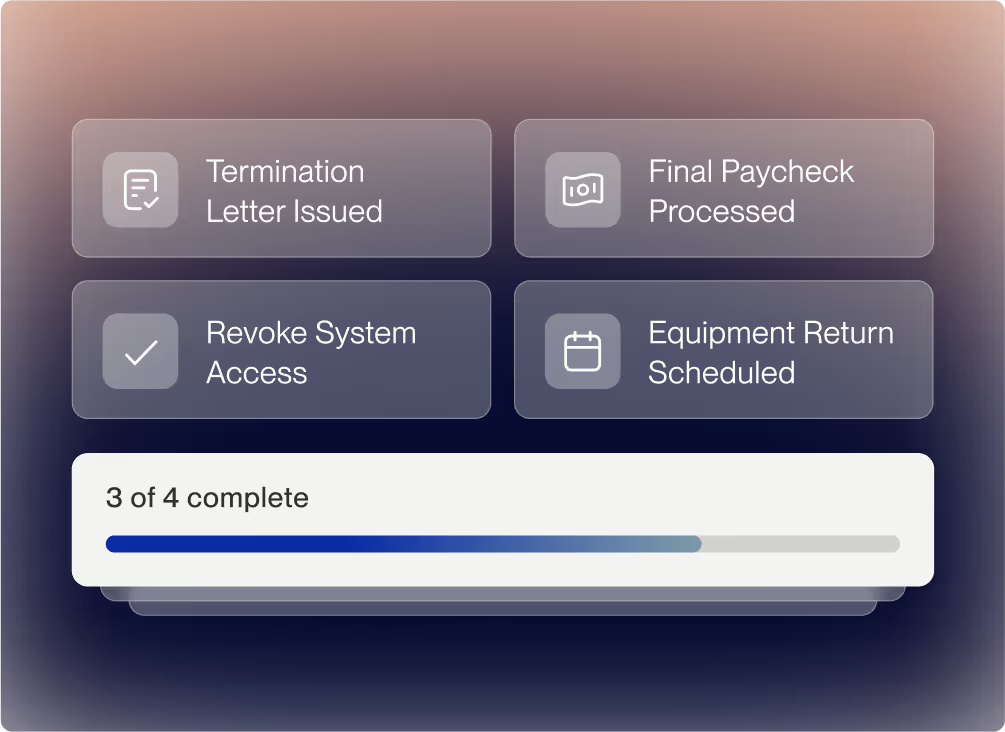
While it’s always hard to say goodbye, it’s inevitable, so make sure you have an ironclad process in place to avoid any mishaps along the way. And whatever the reason for parting ways with your employee, a smooth transition is critical to minimize disruption to your business.
Here's an employee offboarding checklist:
1. Document resignations, layoffs, or terminations
Resignation: Ensure you receive a formal resignation in writing from your employee via email. Usually, a two-week notice is fair, allowing you to transition the team.
Layoff: In the unfortunate event your startup has to conduct layoffs, communicate in a 1:1 meeting with your employee and provide severance pay if you can. Be aware that these meetings can be tense and emotional, so do your best to remain compassionate to help ease tensions. Follow up in writing with a separation agreement sent to their personal email.
Underperformance: In the event of a termination due to underperformance, document performance issues over time. Ideally, provide them with feedback through a Performance Improvement Plan (PIP) that outlines areas for improvement and specific goals to achieve within a specified timeframe. If the performance issues remain unresolved, document them and proceed to termination.
Termination: Communicate the termination decision with your employee in a 1:1 meeting in a non-discriminatory and professional manner. Follow up with a written termination document and separation agreement sent to their personal email. Usually, terminations are effective immediately.
- Termination procedures must be handled with care to avoid wrongful termination claims or lawsuits.
- Always document performance issues.
- All states, except Montana, allow “at-will” employment. This means that either the employer or the employee can end the employment at any time, for any reason. Except for the following reasons, which are protected by law from termination:
- Discrimination based on race, sex, age (40 and over), nation of origin, disability, or genetic information.
- Retaliation for reporting illegal or unsafe workplace practices
- Refusing to conduct illegal activities.
Video - Advice from Rajeev Behera, Founder & CEO of Every and former Co-Founder & CEO of Reflektive on how to fire someone without burning bridges
2. Signed Separation Agreement (layoffs & terminations)
For layoffs and terminations, you’ll want to create a Separation Agreement and ask the departing employee to sign it as a way to terminate your employment contract with them. Separation Agreements can help protect your startup from future lawsuits.
What can be included in a Separation Agreement:
- Severance pay in exchange for the employee waiving the right to any legal claims against the company, such as discrimination, compensation, or any employment law claims.
- Continuation of benefits like COBRA
- Confidentiality clauses
- Non-compete clauses (if your state permits them, check your local regulations).
- Requiring employees to return company property, like laptops
- Get legal help on drafting any separation agreements and check federal and state regulations on what you’re allowed to include.
3. Deactivate IT systems and return company property
Coordinate with IT to deactivate the employee’s access to all company email, messaging, and software systems on the proposed date of termination. Usually, right after you communicate a layoff or termination, it’s best to lock them out of their company laptop and accounts immediately to avoid any issues.
Make sure you change passwords on any shared platforms. Startups often forget to remove ex-employees from their social media accounts. If you just fired someone, you’ll want to be careful.
Ensure the return of all company property, like computers, phones, or access cards.
4. Process final pay and benefits
Coordinate with Payroll to ensure final pay, including vacation and benefits, is distributed promptly according to the employee’s last day of employment.
5. Create an effective handover process
Facilitate a smooth transition by identifying who will take over the departing employee’s responsibilities in the interim.
Create a handover document outlining all the employee’s ongoing projects and identify who will be responsible in the interim.
Ensure any knowledge related to the departing employee is effectively documented and accessible, so other employees have access.
6. Conduct exit interviews
For employee resignations, conduct an exit interview to learn about the employee’s experience at your company and how you can improve as a company culture and as a leader.
7. Communicate the employee’s departure to your team
Communicate the employee’s departure to your team, either during a team meeting or through an email or Slack message, so everyone is informed about the change.
Let them know who will be the responsible person for key projects in the interim as well.
8. Communicate any layoffs or terminations to your state
By law, you’ll also need to communicate any terminations or layoffs to your state to enable employees to access their unemployment benefits.
9. Organize farewell happy hour or lunch (resignation only)
For resignations, consider organizing a company happy hour or lunch to celebrate their accomplishments and wish them well.
Every alumni employee could be a future customer, advocate, referral, or returning employee. So end on a positive note.
Lean on Every’s all-in-one platform for HR onboarding, payroll, taxes, & benefits
Are you feeling a little overwhelmed reading all of this? There’s a lot to do when it comes to bringing on a new hire. We get it. Lean on Every’s modern HR Payroll, Benefits, and Compliance platform to onboard your employees.
Unlike other SMB platforms, Every is built with startups in mind. It’s easy to set up and scales quickly too. Every eliminates the administrative headaches related to onboarding, payroll, and taxes, so you can focus on your vision and avoid any surprise penalties.
Here’s how we do all the heavy lifting for you when it comes to HR:
- Automated onboarding compliance. With Every, you can put payroll taxes, offer letters contingent on background checks, W-9 collection, and 1099 filing on autopilot.
- State tax account setup. We handle state tax registrations and filings, saving founders hours of work and helping you avoid penalties and paperwork.
- International hiring. Every can also help you bring on team members in over 200 countries through our EOR solution or work with international contractors using country-specific contracts – all managed in one place. No legal research, no compliance surprises, just building your best team regardless of borders.
- Affordable benefits: Our tech-specific health benefits packages are built for the modern startup. We’ve navigated these waters ourselves and created options that match what the giants offer without their massive budgets. A dedicated specialist will help you find the sweet spot between competitive benefits and financial sustainability.
Concierge white-glove support. Each client also gets their own Slack connect channel with our in-house specialists. These aren’t outsourced support agents–they’re actual payroll, benefits, and compliance experts who know your specific situation.
{{ebook-quote-6}}

